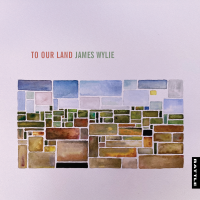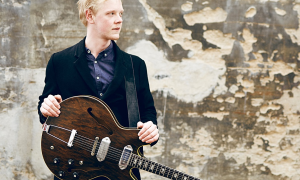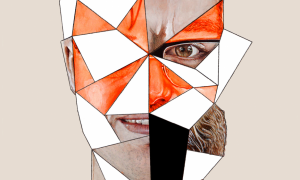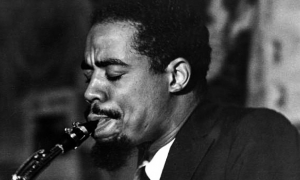Home » Jazz Articles » Hi-Res Jazz » Eric Dolphy: Gone In The Air
Eric Dolphy: Gone In The Air

When you hear music, after it's over, it's gone in the air. You can never capture it again.
—Eric Dolphy
The recording sessions that Eric Dolphy led in the last four years of his life advanced the evolution of jazz. It was a tragedy that Eric Dolphy gave himself so completely and unselfishly to art that he neglected to attend to the mundane demands of bodily health. The impact of his death on June 29, 1964 at age 36 is immeasurable. The sudden loss traumatized his closest friends and deprived the world of his gifts. Dolphy's musical conception was seen by some critics as destructive and incomprehensible, though he affirmed the highest standards of jazz tradition. His most passionate supporters were fellow musical innovators, and his most hostile detractors were complacent musical conservatives. Eric's playing rose up above the din and distractions, like the songs of the birds in his parents' garden.
ACT ONE: preparation
The entrance of Eric Dolphy onto the jazz stage of New York was delayed so long that it could be said the play of his life had only two acts.The first act was set in Los Angeles, where Eric Allan Dolphy was born on June 20, 1928. Eric's musical journey initially followed the same road as many jazz musicians of his generation: instrument study in high school with additional private lessons; then college or conservatory classes in music theory. Dolphy's technical perfectionism and precocious mastery of Charlie Parker's alto saxophone style brought him into contact with composer-bassist Charles Mingus. Eric performed on "The Story of Love," a large-ensemble session in 1949, one of relatively few recordings Mingus made prior to his departure from the West Coast.
In 1952, after a two-year stint in the Army, Dolphy faced the choice of moving to New York with the hope of distinguishing himself in a highly competitive pool of talented bebop players, or staying in Los Angeles and pursuing commercial session work. He chose neither option, and it was a consequential decision. His father improvised a rehearsal studio for him on their property, and for the next six years Eric Dolphy rehearsed privately, and with local and touring musicians. John Coltrane, while on a West Coast tour with the Miles Davis Quintet, visited Eric's studio. Coltrane had only recently emerged from a decade-long rigorous and lonely practice regimen; he understood what Eric was seeking to achieve. The two entered into a close friendship that lasted for the rest of Dolphy's life.
In the 1950s professional jazz musicians paid their dues night after night in smoke-filled clubs. They toured with big bands and small combos, learned how to play to an audience's expectations, and slogged through charts that barely challenged their abilities but earned them a paycheck. For several years, Eric Dolphy paid hardly any of those dues. He found local nightclub work, sometimes in projects with his friends Buddy Colette and Gerald Wilson. What he was hearing had little to do with the West Coast "cool jazz" sound. In long hours rehearsing in his room, he studied the bass clarinet, an orchestral instrument with a four-octave range. Bass clarinet was prominently featured in the work of 20th century Russian and Second Vienna School composers, and brought to a wide listening audience in recorded performances by Harry Carney, a member of the Duke Ellington orchestra. Dolphy's practice regimen allowed him to master this difficult instrument, and to develop a saxophone-like style of playing over the entire range. To Eric, all sounds were beautiful: he listened to the birds in his parents' garden and sought to evoke their songs on his third instrument, the flute.
ACT TWO: performance
At age 30 Eric was propelled out of his rehearsal room onto the wider stage of professional music. Eric's friend Buddy Collette, also a multi-instrumentalist, was leaving the Chico Hamilton band. On Collette's recommendation, Hamilton hired Dolphy and took him on the road and into the studio. Hamilton recorded for nationally-distributed record labels; for the first time, Dolphy's Parkerian alto and distinctive bass clarinet sounds were heard by fellow musicians, critics and jazz listeners. Eric's earliest recording with the Hamilton group was a set of Duke Ellington compositions recorded in August 1958 that producer Dick Bock at Pacific Jazz, reportedly displeased with Eric's distinctive alto saxophone playing, pulled from release. (Chico Hamilton with Eric Dolphy: The Original Ellington Suite was sourced from an LP test pressing located in England and sent to producer Michael Cuscuna, who oversaw its long-belated release in 2000). The setback was a disturbing omen of the critical obstacle course Eric would confront in subsequent years.At the end of 1959, the Chico Hamilton group was disbanded. Dolphy settled in New York, ready for new challenges. He'd felt artistically constrained during his time with Hamilton; he was hearing unusual alternate chords superimposed over the written chords in the charts, and he wanted to play those notes, not just the 'right' notes. Like Mingus, he listened to the developments of 20th century classical music; like Coltrane, he strived to play inside the traditions laid down by preceding generations, but with the freedom to venture outside the boundaries of bebop harmonic conventions.
In a short time, Dolphy advanced to the frontline of new creative music. Signed to the Prestige New Jazz division, he began a busy recording schedule.
Out There
 For his second Prestige session Out There, he requested Ron Carter, with whom he'd played in Chico Hamilton's group. Dolphy conceived of a pianoless quartet with Carter on cello, and no additional horn. Reduction from the standard bebop quintet opened space for an intimate, chamber music style of performance, a framework for Dolphy and Carter to venture "out there." The rhythm section of George Duvivier and Roy Haynes were in the elite of professional musicians, technically equipped to play any style of jazz. Haynes would be Coltrane's choice to fill in for Elvin Jones during Jones' worst period of heroin use.
For his second Prestige session Out There, he requested Ron Carter, with whom he'd played in Chico Hamilton's group. Dolphy conceived of a pianoless quartet with Carter on cello, and no additional horn. Reduction from the standard bebop quintet opened space for an intimate, chamber music style of performance, a framework for Dolphy and Carter to venture "out there." The rhythm section of George Duvivier and Roy Haynes were in the elite of professional musicians, technically equipped to play any style of jazz. Haynes would be Coltrane's choice to fill in for Elvin Jones during Jones' worst period of heroin use. Although not named on the album's liner notes, Esmond Edwards is credited on AllMusic and Discogs with the 'audio production' of Out There. Dolphy's recordings for Prestige, as a leader and as a sideman with Oliver Nelson, Mal Waldron, and Makanda Ken McIntyre, were all produced by Edwards.
Esmond Edwards was an accomplished photographer whose images appear on many classic Prestige and Blue Note covers. He rose from Prestige's mailroom to become an in-house producer. Compared to Blue Note, Prestige was a cut-rate operation; it's a tribute to Edwards' resourcefulness that he could produce a date as accomplished as Out There on the kind of low budgets Prestige owner Bob Weinstock allotted.
From the tightly-arranged alto saxophone and cello unison lines on the title track it is clear that Dolphy and Carter are breathing the same rarefied air. Carter takes the first solo, deploying slurs, slides, bounced bow, and double-stops, a virtuoso display that boasts 'I can play anything you throw at me.' Dolphy constructs an unsettling, innovative melodic solo grounded in familiar rhythmic patterns learned from Charlie Parker's recordings. His articulation is almost preternaturally distinct—the reward of endless hours practicing in his rehearsal room. The long lines of notes, each carrying weight and emphasis, the wide interval leaps and false fingered quarter-tones, the sheer unpredictability of his ideas, generate a sound concept unlike Parker or his successors and imitators.
Dolphy's tribute to Charles Mingus, "The Baron," follows the same structure as "Out There," an opening head of angular lines played in unison, this time by the bass clarinet and cello. A cello solo by Carter ends with Dolphy's sudden entrance—as if he were compelled to interrupt Carter in mid-conversation. Dolphy explores the range of the instrument in a dazzling, modernistic solo. The pressure of recording an album in just a few hours of studio time may have driven his impatience to play as much as possible. There are anecdotes about his tendency to jump in unexpectedly when his fellow players hadn't quite finished.
The arrangement of Mingus' song "Eclipse" with Dolphy on his first instrument, the Bb clarinet, moves the set into chamber music territory. Dolphy interprets the long, sustained-notes theme without undue emphasis, using narrow vibrato, while Carter solos eloquently on the cello and Duvivier bows subtle counter-melodies. Dolphy's solo is a dance-like cascade of melodic invention, with leaps into the upper register and graceful descending arpeggios.
Hale Smith's composition "Feathers," which closes the album, reprises the characteristic alto saxophone sound of Dolphy's earliest work with Chico Hamilton, the purity of tone and masterful control of intonation and dynamics. Over bowed bass and plucked cello, Dolphy expresses more effectively than words can convey the poignant evanescence of the musical moment.
Kevin Gray's excellent new transfer, which is noticeably warmer and more detailed than the earlier Fantasy SACD release, shines a light on the methods used by session engineer Rudy Van Gelder to enhance the unusual qualities of this ensemble. On most of the tunes, Ron Carter's cello is panned to the right channel with Roy Haynes' drum kit, but on some tracks Van Gelder moves him to the center for a closer blend with George Duvivier. RVG's practice of increasing and decreasing the level of reverb in the live mix (made more audible in high resolution), needlessly softens the bite of the bows on strings.
Tracks 1. Out There 2. Serene 3. The Baron 4. Eclipse 5. 17 West 6. Sketch Of Melba 7. Feathers
Personnel Eric Dolphy, alto sax, flute, bass clarinet and Bb clarinet; Ron Carter, cello; George Duvivier, bass; Roy Haynes, drums
Audio production by Esmond Edwards. Recorded at Van Gelder Studio, Englewood Cliffs, NJ, August 15, 1960
Mastered for SACD by Kevin Gray at Cohearent Audio
Live At The Five Spot Vol. 1
 Live performances allowed Dolphy greater freedom to explore the landscape of his personal musical terrain. On the Mal Waldron composition "Fire Waltz" Eric Dolphy's feet are firmly planted in the soil of jazz tradition, but his alto saxophone soars out of the field of bebop clichés. His solo plunges toward harmonic chaos, punctuated by out-of-chord high notes and glossolalia-like figures. Booker Little, whose hard bop lines rarely stray outside the changes, and composer Waldron, who builds the emotional center of his solo on an interpolation of Gershwin's "I Loves You, Porgy," sound conservative by comparison.
Live performances allowed Dolphy greater freedom to explore the landscape of his personal musical terrain. On the Mal Waldron composition "Fire Waltz" Eric Dolphy's feet are firmly planted in the soil of jazz tradition, but his alto saxophone soars out of the field of bebop clichés. His solo plunges toward harmonic chaos, punctuated by out-of-chord high notes and glossolalia-like figures. Booker Little, whose hard bop lines rarely stray outside the changes, and composer Waldron, who builds the emotional center of his solo on an interpolation of Gershwin's "I Loves You, Porgy," sound conservative by comparison. Little's tune "Bee Vamp" features Dolphy on bass clarinet. By the middle of his solo, constrained by Waldron's sympathetic but conventional comping, Dolphy alternates between rapid-fire atonal outbursts and articulate phrases that run closer to the chord changes. The tension between Dolphy's avant-garde leanings and Waldron's traditionalism creates a strangely uncomfortable mood; though the ensemble playing is tight and compelling, the players' conceptions are too diverse for the performances to cohere. Dolphy doesn't need the chain and anchor of received musical wisdom.
The original album's entire Side Two was taken up with a 20-minute performance of a Dolphy piece entitled "The Prophet," a tribute to a painter friend whose artwork appears on the covers of Outward Bound and Out There. Back on alto, Dolphy unleashes a fusillade of fiery and inventive phrases, rising to ecstatic fervor. As a child, Eric, like his friend and sometime bandleader Charles Mingus, attended church services that inspired parishioners to spontaneously 'speak in tongues.' As an adult, he was the assistant director of the junior choir at Westminster Presbyterian Church, and a member of its senior choir. He played piano and organ, and had he not been so in thrall to the music of Ellington and Charlie Parker, Eric Dolphy might have committed his life to sacred rather than art music. (Citing Horricks, Raymond, The Importance of Being Eric Dolphy, Tunbridge Wells: D J Costello (Publishers), Ltd., 1989)
In the studio, Eric Dolphy had collaborated successfully with Mal Waldron (The Quest) and Booker Little (Dolphy's Far Cry and Little's Out Front) . But on the evidence of these live performances, Dolphy's restless and untrammeled imagination led to an unresolvable tension with those same colleagues, and restrained the impact of his innovative voice.
Mastering engineer Kevin Gray does wonders with this venerable tape. Distortion is generally low and the clarity of the transfer brings the performances into sharp focus. Rudy Van Gelder had the unenviable task of balancing Eric Dolphy, who Mingus once described as possessing the loudest projection of any saxophonist since Coleman Hawkins, against Mal Waldron's subtle, restrained playing on the Five Spot's out-of-tune piano, Richard Davis' bass, which had a lean timbre with relatively little deep resonance, Booker Little's trumpet and Ed Blackwell's close-miked drums. An enthusiastically appreciative audience adds immediacy to the recording.
Tracks 1. Fire Waltz 2. Bee Vamp 3. The Prophet
Personnel Eric Dolphy, alto sax, bass clarinet, flute; Booker Little, trumpet; Mal Waldron, piano; Richard Davis, bass; Ed Blackwell, drums
Production supervision by Esmond Edwards. Recorded by Rudy Van Gelder at the Five Spot Café, NYC, July 16, 1961.
Mastered for SACD by Kevin Gray at Cohearent Audio \
Critical Notices
Eric Dolphy contributed to the some of the most conceptually advanced projects in new jazz. He performed and recorded with Charles Mingus' Jazz Workshop at concerts in Europe and club dates in New York; recorded three studio albums for Prestige under his own leadership; participated in a Third Stream music project with composer Gunther Schuller; appeared alongside Ornette Coleman on the iconic album Free Jazz; and resumed a musical conversation with John Coltrane that would culminate in the November 1961 shows at the Village Vanguard that provoked a hostile attack from John Tynan at Down Beat magazine:Coltrane and Dolphy seem intent on deliberately destroying swing. They seem bent on pursuing an anarchistic course in their music that can only be termed anti-jazz.
Even though Down Beat (several months later) offered Coltrane and Dolphy a forum to reply to their critics, the epithet "anti-jazz" was wounding and humiliating. Ill-informed commentary from Tynan, Leonard Feather and other prominent jazz writers, coming at a time when the music was undergoing an organic evolution into new directions, performed a disservice to the entire jazz community and significantly impeded Eric's professional progress. His discography for the following year, 1962, lists no studio recordings under his leadership. He was barely able to make the rent.
Without label support and lacking a large enough audience to retain a regular working band, in the teeth of his tone-deaf critics, Eric Dolphy recorded two studio sessions of increasingly avant-garde music for independent producer Alan Douglas in July 1963. Iron Man and Conversations document Eric's continuing development as a composer and interpreter, and his discernment in identifying younger, promising musicians. The sessions are noteworthy for the presence of Bobby Hutcherson on vibes and Richard Davis on bass, who would make important contributions to Dolphy's subsequent—and final—studio recording.
If the original tapes for the July 1963 sessions are intact, they should be archived and reissued in high resolution digital and LP format. Currently, they are out of print in licensed US editions, and only available on out-of-copyright EU releases.
Out to Lunch!
 Why did it take Blue Note Records chief Alfred Lion so long to sign Eric Dolphy? By November 1963, Blue Note had recorded musically adventurous sessions led by Jackie McLean, Grachan Moncur III, Sam Rivers and Andrew Hill. Jazz was evolving, and wisely, Alfred Lion committed to signing artists who were pursuing new directions.
Why did it take Blue Note Records chief Alfred Lion so long to sign Eric Dolphy? By November 1963, Blue Note had recorded musically adventurous sessions led by Jackie McLean, Grachan Moncur III, Sam Rivers and Andrew Hill. Jazz was evolving, and wisely, Alfred Lion committed to signing artists who were pursuing new directions. The February 8, 1964 session that produced Out to Lunch! closely followed Bobby Hutcherson's first Blue Note session (The Kicker, December 1963) and precedes the August 1964 session led by Tony Williams ( Anthony Williams—Life Time). Tony Williams, a precocious percussion virtuoso, was championing the new music of Dolphy, Andrew Hill and Sam Rivers. Having his original compositions recorded in an ensemble of like-minded players who thoroughly grasped his approach, and released by a major record company was the best chance for Eric Dolphy to overcome the stigma attached to the specious label "anti-jazz" and to further his artistic aims.
All the hours of diligent private rehearsal, the demanding apprenticeship with Charles Mingus, the sympathetic encounters with musicians in New York and Europe, and the humiliating attacks by hidebound critics come together in these five performances. Dolphy's conception is now fully realized; he is free to brush brilliant hues and scrape deep textures across the musical canvas. What was lacking in the Booker Little/Mal Waldron ensemble, empathic communication between the players, is vividly present from the opening bars of "Hat and Beard." In Tony Williams, Eric Dolphy finds his Elvin Jones. Williams cavorts, rolls, pounces, explodes in response to Dolphy's bass clarinet multiphonic growls, impossibly fast runs, dizzying subdivisions of meter. Bassist Richard Davis and vibraphonist Bobby Hutcherson engage in a conversation of plucked strings and mallet strikes.
Freddie Hubbard, listening closely to what's happening in the piece and challenged to stretch outside his familiar bag of riffs, meets the avant-gardists halfway by incorporating some Dolphy-esque wide-interval leaps and rhythmic figures into his solo. It was perhaps a calculated risk to include Hubbard in the session. He's grounded in bebop, which makes him sound less adventurous than the other members of the ensemble, but his inventive playing and impressive technique keeps the door open to the wider jazz listenership, who had lost too many young trumpet stars in the preceding decade.
For those readers who download the album in hi-res audio, some suggestions for close listening:
"Something Sweet, Something Tender": Near the end, Dolphy's bass clarinet in unison duet with Richard Davis's bowed bass, a small jewel of 20th-century chamber music.
"Out to Lunch" and "Straight Up and Down": The emotive impact of Eric's new, harsh alto saxophone sound, liberated from the conventions of classical tone production—a different kind of beauty; the rhythm section pounding disruptive accents under Hubbard's solo; Hutcherson and Davis improvising in full confidence of their melodic imaginations.
Alan Yoshida's transfer of the original master tape blasts the dust off the windows—you can hear the most subtle nuances of bass clarinet embouchure and feel the impact of sticks pounding drumheads.
Tracks 1. Hat and Beard 2. Something Sweet, Something Tender 3. Gazzelloni 4. Out to Lunch 5. Straight Up and Down
Personnel Eric Dolphy, alto sax, bass clarinet, flute; Freddie Hubbard, trumpet; Bobby Hutcherson, vibes; Richard Davis, bass; Anthony Williams, drums. Recorded at Van Gelder Studio, Englewood Cliffs, NJ, February 25, 1964. High-Resolution Mastering (192/24) by Alan Yoshida and Robin Lynn at Blanche Dubois, April 2012.
Curtain
A tour of Europe in spring 1964, which briefly reunited him with Charles Mingus and was well documented in concert recordings, prompted a premature end to Eric Dolphy's second act. Though Mingus made it painfully clear that he wanted Eric to return to the US, Dolphy chose to remain in Europe. At the end of a club engagement in Berlin, he collapsed and was taken to a hospital where doctors treated him unsuccessfully for diabetic coma.The years of constant musical self-emptying left Eric Dolphy no time to attend to the physical toll of the undertaking; for the lack of preventive health care and routine blood testing, a genius of modern American music was lost.
Eric Dolphy's conception of the alto saxophone honored the contributions of Charlie Parker while taking wing in new harmonic directions. As a jazz bass clarinetist he was, and remains, without peer; a sound innovator and an inspiration for subsequent generations of musicians.
Eric said: When you hear music, after it's over, it's gone in the air. You can never capture it again.
But if you listen closely, you can still hear the echoes.
So long, Eric.
CODA: Eric Dolphy on SACD and hi-res downloads (as of June 2018)
As a leader:
Out There Analogue Productions SACD
Live at the Five Spot Analogue Productions SACD
Outward Bound Analogue Productions SACD (scheduled for release)
Far Cry Analogue Productions SACD (scheduled for release)
Out to Lunch! Blue Note 192/24 download and Universal Japan SHM-SACD
with John Coltrane
Africa/Brass Verve Reissues 24/192 download
Live at the Village Vanguard Verve Reissues 24/192 download
with Freddie Hubbard
The Body and the Soul Analogue Productions SACD and DSD download
with Charles Mingus
Mingus, Mingus, Mingus, Mingus, Mingus Analogue Productions SACD and DSD download
with Oliver Nelson
The Blues and the Abstract Truth Analogue Productions SACD and DSD download
Screamin' the Blues Analogue Productions SACD
Tags
Hi-Res Jazz
Mark Werlin
Eric Dolphy
Charlie Parker
Charles Mingus
John Coltrane
Miles Davis
Harry Carney
duke ellington
Buddy Collette
Chico Hamilton
Ron Carter
George Duvivier
Roy Haynes
Elvin Jones
Esmond Edwards
Oliver Nelson
Mal Waldron
Ken McIntyre
rudy van gelder
Booker Little
Gunther Schuller
Ornette Coleman
PREVIOUS / NEXT
Support All About Jazz
 All About Jazz has been a pillar of jazz since 1995, championing it as an art form and, more importantly, supporting the musicians who make it. Our enduring commitment has made "AAJ" one of the most culturally important websites of its kind, read by hundreds of thousands of fans, musicians and industry figures every month.
All About Jazz has been a pillar of jazz since 1995, championing it as an art form and, more importantly, supporting the musicians who make it. Our enduring commitment has made "AAJ" one of the most culturally important websites of its kind, read by hundreds of thousands of fans, musicians and industry figures every month.
























